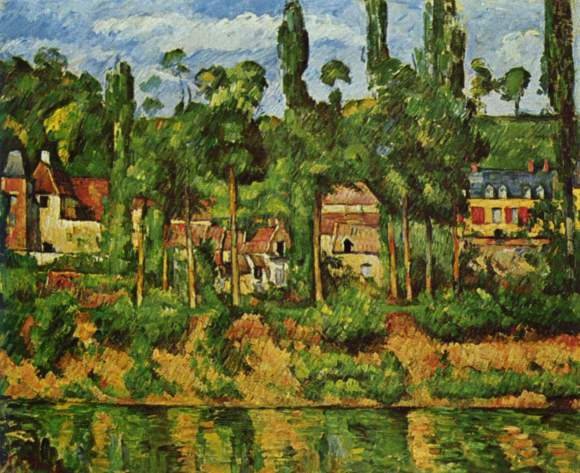In a piece on Cézanne’s Banks of the Marne, published on this site several weeks ago, I mentioned and briefly considered, by way of comparison, the painting Zola’s House at Médan. The painting is just as often referred to as Le Château de Médan; it was painted between 1879 and 1881; and is now part of the Burrell Collection in Glasgow.
Over the last week I have been reading through a book on Cézanne by Hajo Düchting, published by Taschen, entitled on the front cover simply Cézanne; with the title page expanding upon this via the provision of a subtitle, 1839-1906, Nature into Art. The book makes particular mention of Zola’s House at Médan; and includes a lengthy quotation by Gauguin which I thought was worth republishing here.
Gauguin is recorded as the painting’s first owner, purchasing it from the Parisian art supplier and art dealer Julien François Tanguy. Over the course of years, Tanguy established in his shop quite a collection of Impressionist paintings, owing to the fact that, where money was lacking, he accepted paintings in exchange for paints. He was called Père by his artists, and sold, or attempted to sell, works by Monet, Sisley, Seurat and Van Gogh alongside Cézanne and Gauguin. Van Gogh painted him three times, the latter two paintings increasingly experimental, Japanese-inspired portraits.
Gauguin’s remarks provide us with his own sense of the interplay of colours in Cézanne’s painting. They continue with a second-hand account of an occurrence which took place with Cézanne mid-paint. This account is humorous in its evocation of the professorial passer-by, it provides a nice depiction of Cézanne’s character, and it is also a suggestive shot of a perhaps not atypical contemporary response to Cézanne’s work. Here is Gauguin:
Cézanne is painting a shimmering landscape against an ultramarine background, with intense shades of green and ochre gleaming like silk. The trees are stood in a row like tin soldiers, and through the tangle of branches you can make out his friend Zola’s house. Thanks to the yellow reflections on the whitewashed walls, the vermilion window shutters take on an orange tone. A crisp Veronese green convey the sumptuous leafage in the garden, and the sobre, contrasting shade of bluish nettles in the foreground renders the simple poem even more sonorous.
A presumptuous passer-by takes a shocked glance at what seems, in his eyes, to be a dilettante’s wretched daubing, and asks Cézanne in a professorial voice, with a smile,
‘Trying your hand at painting?’
‘Yes – but I’m no expert!’
‘I can see that. Look here, I was once a pupil of Corot. If you don’t mind, I’ll just add a few well-placed strokes and set the whole thing right. What count are the valeurs, and the valeurs alone.’
And sure enough, the vandal adds a few strokes of paint to the shimmering picture, utterly unabashed. The oriental silk of this symphony of colour is smothered in dirty greys. Cézanne exclaims: ‘Monsieur, you have an enviable talent. No doubt when you plant a portrait you put shiny highlights on the tip of the nose just as you would on the bars of a chair.’
Cézanne picks up his palette once more and scratches off the mess he has made. Silence reigns for a moment. Then Cézanne lets fly a tremendous fart, and, gazing evenly at the man, declares: ‘That’s better.’









